Related Research Articles
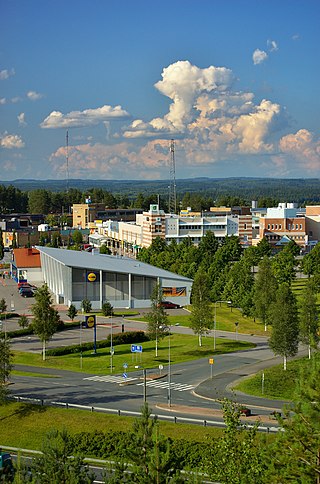
A supermarket is a self-service shop offering a wide variety of food, beverages and household products, organized into sections. This kind of store is larger and has a wider selection than earlier grocery stores, but is smaller and more limited in the range of merchandise than a hypermarket or big-box market. In everyday U.S. usage, however, "grocery store" is often used to mean "supermarket".
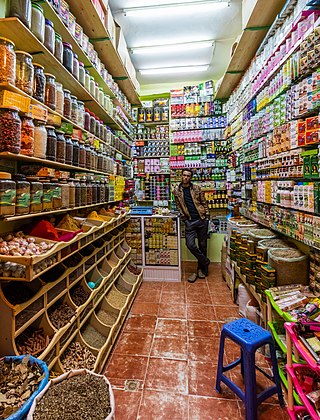
Retail is the sale of goods and services to consumers, in contrast to wholesaling, which is sale to business or institutional customers. A retailer purchases goods in large quantities from manufacturers, directly or through a wholesaler, and then sells in smaller quantities to consumers for a profit. Retailers are the final link in the supply chain from producers to consumers.
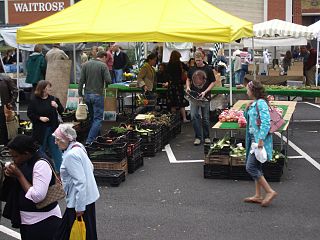
Local food is food that is produced within a short distance of where it is consumed, often accompanied by a social structure and supply chain different from the large-scale supermarket system.

A grocery store (AE), grocery shop (BE) or simply grocery is a store that primarily retails a general range of food products, which may be fresh or packaged. In everyday U.S. usage, however, "grocery store" is a synonym for supermarket, and is not used to refer to other types of stores that sell groceries. In the UK, shops that sell food are distinguished as grocers or grocery shops.

Distribution is the process of making a product or service available for the consumer or business user who needs it, and a distributor is a business involved in the distribution stage of the value chain. This can be done directly by the producer or service provider or using indirect channels with distributors or intermediaries. Distribution is one of the four elements of the marketing mix: the other three elements being product, pricing, and promotion.

Food distribution is the process where a general population is supplied with food. The Food and Agriculture Organization (FAO) considers food distribution as a subset of the food system. The process and methodology behind food distribution varies by location. Food distribution has been a defining characteristic of human behavior in all societies, and recordings of food distribution date back for thousands of years. Most governments and societies are highly shaped by the systems created to support food distribution.

Food miles is the distance food is transported from the time of its making until it reaches the consumer. Food miles are one factor used when testing the environmental impact of food, such as the carbon footprint of the food.

A wet market is a marketplace selling fresh foods such as meat, fish, produce and other consumption-oriented perishable goods in a non-supermarket setting, as distinguished from "dry markets" that sell durable goods such as fabrics, kitchenwares and electronics. These include a wide variety of markets, such as farmers' markets, fish markets, and wildlife markets. Not all wet markets sell live animals, but the term wet market is sometimes used to signify a live animal market in which vendors slaughter animals upon customer purchase, such as is done with poultry in Hong Kong. Wet markets are common in many parts of the world, notably in China, Southeast Asia, and South Asia. They often play critical roles in urban food security due to factors of pricing, freshness of food, social interaction, and local cultures.
Food politics is a term which encompasses not only food policy and legislation, but all aspects of the production, control, regulation, inspection, distribution and consumption of commercially grown, and even sometimes home grown, food. The commercial aspects of food production are affected by ethical, cultural, and health concerns, as well as environmental concerns about farming and agricultural practices and retailing methods. The term also encompasses biofuels, GMO crops and pesticide use, the international food market, food aid, food security and food sovereignty, obesity, labor practices and immigrant workers, issues of water usage, animal cruelty, and climate change.
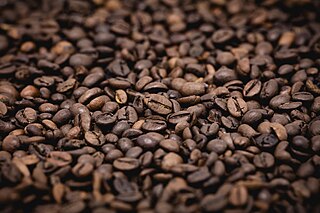
Coffee is a popular beverage and an important commodity. Tens of millions of small producers in developing countries make their living growing coffee. Over 2.25 billion cups of coffee are consumed in the world daily that amounts to 2.5 cups of coffee consumed per person on average. Over 90 percent of coffee production takes place in developing countries—mainly South America—while consumption happens primarily in industrialized economies. There are 25 million small producers who rely on coffee for a living worldwide. In Brazil, where almost a third of the world's coffee is produced, over five million people are employed in the cultivation and harvesting of over three billion coffee plants; it is a more labor-intensive culture than alternative cultures of the same regions, such as sugar cane or cattle, as its cultivation is not automated, requiring frequent human attention.
Fast fashion is a term used to describe the clothing industry's business model of replicating recent catwalk trends and high-fashion designs, mass-producing them at a low cost, and bringing them to retail stores quickly, while demand is at its highest. The term fast fashion is also used generically to describe the products of the fast fashion business model.
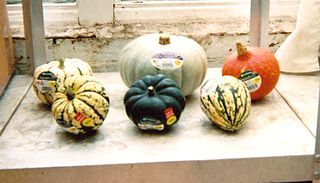
Food marketing brings together the food producer and the consumer through a chain of marketing activities.

Retailing in India is one of the pillars of its economy and accounts for about 10 percent of its GDP. The Indian retail market is estimated to be US$ 600 billion and one of the top five retail markets in the world by economic value. India is one of the fastest growing retail markets in the world, with 1.2 billion people.
Supermarket shortages have been identified in many American urban neighborhoods, and such gaps in food access have been closely correlated with diet-related diseases such as cancer, obesity, and diabetes. The shortage began when many supermarkets left mixed-income central city neighborhoods after civil disturbances in the late 1960s and 1970s. By 1984, store openings exceeded closings nationally but the opposite held in cities and the trend continues. The reluctance of large chains to open in urban areas is termed by some activists, "supermarket redlining."

Agricultural marketing covers the services involved in moving an agricultural product from the farm to the consumer. These services involve the planning, organizing, directing and handling of agricultural produce in such a way as to satisfy farmers, intermediaries and consumers. Numerous interconnected activities are involved in doing this, such as planning production, growing and harvesting, grading, packing and packaging, transport, storage, agro- and food processing, provision of market information, distribution, advertising and sale. Effectively, the term encompasses the entire range of supply chain operations for agricultural products, whether conducted through ad hoc sales or through a more integrated chain, such as one involving contract farming.

Everyday low price is a pricing strategy promising consumers a low price without the need to wait for sale price events or comparison shopping. EDLP saves retail stores the effort and expense needed to mark down prices in the store during sale events, and is also believed to generate shopper loyalty. It was noted in 1994 that the Walmart retail chain in the United States, which follows an EDLP strategy, would buy "feature advertisements" in newspapers on a monthly basis, while its competitors would advertise weekly. Other firms that have implemented or promoted EDLP are Procter & Gamble, Food Lion, Gordmans and Winn-Dixie.
The Global Food Safety Initiative (GFSI) is a private organization working as a "Coalition of Action" from The Consumer Goods Forum (CGF) bringing together retailers and brand owners (manufacturers) from across the CGF membership operating as multistakeholder governance with objective to create "an extended food safety community to oversee food safety standards for businesses and help provide access to safe food for people everywhere". GFSI's work in benchmarking and harmonization aims to foster mutual acceptance of GFSI-recognized certification programmes across the industry with the ambition to enable a “once certified, accepted everywhere” approach.

Hannaford is an American supermarket chain based in Scarborough, Maine. Founded in Portland, Maine, in 1883, Hannaford operates stores in New England and New York. The chain is now part of the Ahold Delhaize group based in the Netherlands, and is a sister company to formerly competing New England supermarket chain Stop & Shop.
This is a list of food desert issues and solutions by country.
The retail format influences the consumer's store choice and addresses the consumer's expectations. At its most basic level, a retail format is a simple marketplace, that is; a location where goods and services are exchanged. In some parts of the world, the retail sector is still dominated by small family-run stores, but large retail chains are increasingly dominating the sector, because they can exert considerable buying power and pass on the savings in the form of lower prices. Many of these large retail chains also produce their own private labels which compete alongside manufacturer brands. Considerable consolidation of retail stores has changed the retail landscape, transferring power away from wholesalers and into the hands of the large retail chains.
References
- ↑ "Consumers Drive Food Industry Transformation -- Global Brands, Retail Formats, Consolidation -- Says New Report | News | Capgemini | Consulting, Technology, Outsourcing". Archived from the original on 2008-07-20. Retrieved 2008-12-10.[ full citation needed ]
- ↑ Hollingsworth, Andrew (2004). "Increasing retail concentration: Evidence from the UK food retail". British Food Journal. British Food Journal vol. 106. 106 (8): 629–638. doi:10.1108/00070700410553611. Archived from the original on 2012-10-23. Retrieved 2012-07-07.
- ↑ "State of the Art in Food - Elsevier Food International". Archived from the original on December 4, 2008. Retrieved December 10, 2008.
- ↑ http://www.foodinternational.net/articles/efi-special/583/private-labels-why-europe-is-leading-the-pack.html [ dead link ]
- ↑ http://ec.europa.eu/economy_finance/thematic_articles/article13524_en.htm Archived 2008-12-19 at the Wayback Machine [ full citation needed ]
- ↑ International Journal of Behavioral Nutrition and Physical Activity, 2006 3: 33 “Understanding environmental influences on nutrition and physical activity behaviors: where should we look and what should we count?”, Kylie Ball, Anna F Timperio and David A Crawford
- ↑ Chowdhury, Shyamal; Ashok Gulati; E. Gumbira Sa'id (June–December 2005). "The Rise of Supermarkets and Vertical Relationships in the Indonesian Food Value Chain" (PDF). Asian Journal of Agriculture and Development. 2 (1 & 2). Archived from the original (PDF) on 2008-12-03. Retrieved 2008-12-10.
- ↑ http://www.agobservatory.org/library.cfm?RefID=46604 [ dead link ]